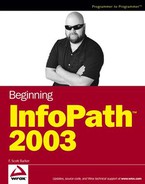8.1. Overview of Types of Sections in an InfoPath Form
InfoPath provides various types of sections depending on the task you need to accomplish. These sections are added to forms as controls and contain other controls within them. The majority also are bound to groups of data. A group of data is related records in one of the tables included in a data source, usually in a one-to-many relationship.
An example of using a bound section is an optional section. An optional section is a repeating section where data can be entered, but is not required. An example of an optional section is one bound to the tblCustomerNotes table, which is related to tblCustomers on the CustomerID field. As with other data tasks, InfoPath will take care of a lot of the work to handle adding the data in the CustomerID field in the related table, based on how you set up the section.
Setting up some of the types of sections is covered throughout the rest of the chapter, but for now, take a look at the types of sections available on InfoPath forms, and how you would use them. Some of the controls can be found in the Sections task pane of the Controls task pane.
Choice Section: These are individual sections that are used in a Choice Group control. This control lets you specify fields to fill in based on a choice the user makes. You can also add a repeating choice group when you want to add more than one entry for the choice.
List Control: Though it is technically not a section, it is worth mentioning the List control because it displays data in a section-like manner. There are three flavors of lists: bulleted, numbered, and plain. You can bind list controls to data or let the users create the lists on the fly.
Master/Detail Section(s): Used to represent a one-to-many relationship, these type of sections are created in one of two different ways: manually, by putting a repeating table and repeating section on the same form, or by choosing a Master/Detail control (version 1.1) and filling out the properties.
Optional Section: As the name suggests, the data in this section is optional, thus it takes up no room on a form if it is not needed. A notes section for products is a good example of this. Not every product is going to have a note, so why take up the room?
Repeating Section: This is probably the most used type of section, whenever groups of data are used. Examples are customers, orders, or products. All of these groups of information can be managed using repeating sections.
Repeating Recursive Section: One of the most confusing section controls, this control lets you embed other controls, including itself, so that you can recursively display and enter information. An example of this is a hierarchical employee chart, where employees can be specified at different levels with the same fields being used.
Scrolling Region: As with the list control, the scrolling region is not described as a section, but displays data in a section-like format. Other controls can be placed in a scrolling region control so that instead of scrolling down a whole form, users scroll down in a specific area.
